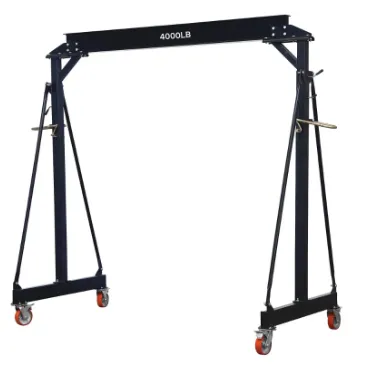Compatibility Analysis of Adjustable Gantry Crane with Various Lifting Tools
Adjustable gantry crane, as a flexible and efficient lifting equipment, plays an increasingly important role in modern industrial production and logistics transportation. Its biggest advantage lies in its adjustable height and span, which allows it to adapt to goods of different sizes and shapes, as well as different types of work environments. However, in order to fully utilize the performance of the adjustable height gantry crane, compatibility issues with various lifting tools must be considered. This article will delve into the compatibility of Adjustable Gantry Crane with various commonly used lifting tools and analyze the key factors that affect compatibility.

adjustable gantry crane: From the perspective of the connection method of the lifting tool
Adjustable gantry cranes are usually equipped with standard hook or loop interfaces, which make them compatible with various lifting tools that use standard connection methods. For example, chain hoists, wire rope electric hoists, loop chain electric hoists, etc. can be directly connected to the lifting trolley of the gantry crane through hooks or shackles to achieve the lifting of goods. In addition, for some special lifting tools, such as vacuum suction cup lifting equipment, magnetic lifting equipment, fixtures, etc., they usually need to be connected to the gantry crane through customized connection devices. Therefore, when selecting or customizing lifting tools, it is necessary to fully consider their compatibility with the connection interface of the gantry crane to ensure the firmness and safety of the connection.
adjustable gantry crane: From the perspective of the load-bearing capacity of lifting tools
Portable adjustable gantry cranes typically have a large load-bearing capacity and can meet the needs of most lifting operations. However, in practical applications, it is necessary to match the rated load of the gantry crane and the rated load of the lifting tool reasonably. Choosing lifting tools with a carrying capacity less than or equal to the rated load of the gantry crane can ensure the safety of lifting operations and avoid equipment damage and safety accidents caused by overloading.
adjustable gantry crane: From the perspective of the operation mode of lifting tools
Tri adjustable gantry cranes Height and position can be manually adjusted, while lifting tools may require a separate control system. Therefore, when carrying out lifting operations, it is necessary to coordinate the operation of the gantry crane and the lifting tools to ensure the synchronization and safety of the operation. For example, when using a vacuum suction cup lifting device, it is necessary to first operate the gantry crane to move the suction cup to the target position, then start the suction cup to adsorb the goods, and then operate the gantry crane for lifting.
From the application scenarios of lifting tools, different lifting tools are suitable for different job scenarios
For example, chain hoists are suitable for precise positioning and fine-tuning operations, wire rope electric hoists are suitable for fast lifting of heavy goods, and vacuum suction cup lifting devices are suitable for lifting objects with smooth surfaces. When selecting lifting tools, it is necessary to choose the most suitable lifting tool according to the actual job requirements to improve the efficiency and safety of lifting operations.
In summary, the compatibility of adjustable gantry crane with various lifting tools is a complex issue that requires comprehensive consideration of multiple factors such as connection mode, load-bearing capacity, operation mode, and application scenarios. Only by fully understanding these factors and making reasonable matching and selection can we fully leverage the advantages of adjustable gantry cranes, improve the efficiency and safety of lifting operations, and provide reliable guarantees for modern industrial production and logistics transportation.
-
Dawei Hand Pallet Truck 1200mm, 2000–5000 KGS Heavy-DutyNouvellesNov.17,2025
-
Dawei Hand Pallet Truck, Fork Length 1200mm, 2000–5000kgNouvellesNov.17,2025
-
Large Equipment Movers – Safe, Insured & On-Time ServiceNouvellesNov.17,2025
-
Machine Moving Dollies | Heavy-Duty, Low-Profile, SafeNouvellesNov.17,2025
-
Permanent Lifting Magnet - Heavy-Duty, Safe, Quick ReleaseNouvellesNov.11,2025
-
PML 1000 Lifting Magnet - Heavy-Duty, Safe, No PowerNouvellesNov.11,2025
-
Large Equipment Movers: Safe, Fast, Certified ProsNouvellesNov.11,2025
